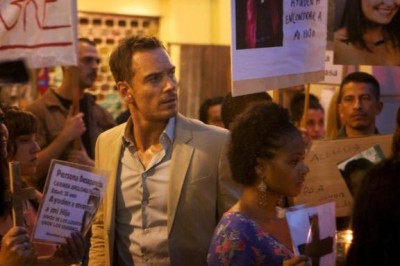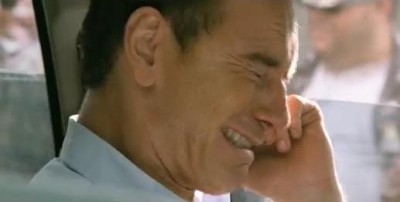A Lack of Character in
Cormac McCarthy’s “The Counselor”
and “Blood Meridian”
Adina Fried
Cormac McCarthy, “The Counselor” (2013)
 A common, little exercise in existential angst: driving on the highway, think of the other cars not just as vehicles, but in terms of the people driving them. Try to imagine them behind the wheel, just like you, leading whole lives as complicated as your own. They, too, are all driving from one place to another, trying to get home, or to school, or Orlando. Each has a family with complex dynamics, like yours, and each has a whole past full of thoughts and personality. You will probably never see any of these now-slightly-less-anonymous drivers again, and you will probably never even cross their minds. Whenever I drive, I try this practice, but I can only hold others’ consciousness in my mind, honestly, for a few seconds, maybe half a minute, until I’m overwhelmed and retreat to thinking of them simply as the things making other cars go, a natural part of the world that just exists.
A common, little exercise in existential angst: driving on the highway, think of the other cars not just as vehicles, but in terms of the people driving them. Try to imagine them behind the wheel, just like you, leading whole lives as complicated as your own. They, too, are all driving from one place to another, trying to get home, or to school, or Orlando. Each has a family with complex dynamics, like yours, and each has a whole past full of thoughts and personality. You will probably never see any of these now-slightly-less-anonymous drivers again, and you will probably never even cross their minds. Whenever I drive, I try this practice, but I can only hold others’ consciousness in my mind, honestly, for a few seconds, maybe half a minute, until I’m overwhelmed and retreat to thinking of them simply as the things making other cars go, a natural part of the world that just exists.
This quality of existing, of life simply happening, is what elevates “Blood Meridian or the Evening Redness in the West”—Cormac McCarthy’s masterpiece according to many—to a plane where words and the images they seem to, by chance, create, carry immense weight. The characters in “Blood Meridian” are not entirely simple, but readers are granted only a simple view into their personalities. At times, they’re even only given as much psychology as the dogs in the street:
Two other dogs sat a little apart, squatting loosely in their skins, just frames of dogs in napless hides watching the coupled dogs and then watching the prisoners clanking away up the street. All brightly shimmering in the heat, these lifeforms, like wonders much reduced. Rough likenesses thrown up at hearsay after the things themselves had faded in men’s minds.1
McCarthy’s characters—the kid, Glanton, Judge Holden—they’re beings that move through the world, acting and being acted upon, simply part of the natural landscape. McCarthy’s approach in “Blood Meridian” is a refreshing take on the novel, an art form so often driven by character and psychology. Instead of feelings and moral dilemmas, readers are presented with the truly “mindless violence”2 of the McCarthian world. This is its natural state. So when a truly bloody scene greets readers, it does so slyly, waiting to announce its gore until after the passage has been read. Take, for example, perhaps the most famously gruesome passage in the book: the attack on the plain that starts with the appearance of, “a legion of horribles.”3 From seemingly out of nowhere, hundreds of riders descend on Glanton’s group, dressed in the spoils of war, “one in a stovepipe hat and one with an umbrella and one in white stockings and a bloodstained weddingveil and some in headgear of cranefeathers or rawhide helmets that bore the horns of bull or buffalo and one in a pigeontailed coat worn backwards and otherwise naked….” The slaughter begins immediately. The “horribles” break Glanton’s ranks rather easily and begin
stripping the clothes from the dead and seizing them up by the hair and passing their blades about the skulls of the living and the dead alike and snatching aloft the bloody wigs and hacking and chopping at the naked bodies, ripping off limbs, heads, gutting the strange white torsos and holding up great handfuls of viscera, genitals, some of the savages so slathered up with gore they might have rolled in it like dogs and some who fell upon the dying and sodomized them with loud cries to their fellows… [E]verywhere the dying groaned and gibbered and horses lay screaming.
The oversaturation of violence and blood emphasized by the long sentences whose ends seem too distant to even contemplate, almost blinds readers to the true grossness of the events described. So much happens without an instigator, without an actor intent on making decisions—without even a leader on horseback announcing the charge—the blood and gore seeming to be mere side effects of the earth’s natural rotation. When finally able to imagine the scene, we are left to interpret it on our own, no emotional narrator or character to guide us, and it’s horrifying.
It was with high hopes for some similarly horrifying and exciting subversion of the big-budget suspense film that I went to see McCarthy’s “The Counselor,” the first major film whose screenplay he’s authored. The movie is about a lawyer (referred to only as Counselor, played by Michael Fassbender) who gets in too deep on a drug deal gone wrong despite the constant and seemingly well-meant warnings of those around him. The Counselor knowingly makes the descent from a pure and wholesome world full of brightly-lit rooms and virginal fiancées to the gritty underbelly of the Mexican desert, all browns and grays and dirt and blood. We’re never given any details of the deal that causes his fall; almost the opposite of “Blood Meridian” in narrative structure, “The Counselor” is all about its characters and their emotions, eschewing plot for psychology almost completely.
The film is not entirely free of McCarthy’s signatures, however; violent and disturbing images appear every twenty minutes or so to remind us just whose movie this is. Multiple beheadings, graphic fetishes, dead bodies suspended in embalming fluid: the violence of these scenes contrasts so sharply with the overwrought, philosophical monologues on the nature of beauty, greed, and sex in which almost every character (but not the Counselor) indulges so that the images meant to horrify us seem almost comical. Towards the end of the film, after everything’s gone south, the Counselor sits in his car, searching desperately for his fiancée (Penelope Cruz). After listening to a drug lord ruminate on the Counselor’s follies and greed, maintaining there’s nothing his can do, he got what’s coming to him, the Counselor sobs loudly and helplessly, his appearance unconvincing. Immediately following this rather obtuse display of emotion, we see Cruz’s body, headless, dumped on a landfill, detritus with the rest. Innocence has been corrupted; those not guilty are punished for others’ mistakes.
 This scene, meant to be poignant or sad or disgusting, made me laugh. In an attempt to give us the private worlds of characters, McCarthy dishes out personalities that are single-toned and flat: Counselor’s fiancée is all-pure, Reiner (Javier Bardem) is blinded by lust, Westray (Brad Pitt) is the experienced one who knows how to cut ties and run. Even Malkina (Cameron Diaz), the most odd, if not quite intriguing, character of all, is reduced to the power-driven, crazy woman who’ll kill all to get what she wants. The problem is that we don’t know what it is any of these characters actually want, because McCarthy won’t tell us. The film speaks entirely in generalities, so it ends up speaking about nothing at all. In a fictional world with no stakes, horror and gore have no effect, and McCarthy’s signature images become jokes.
This scene, meant to be poignant or sad or disgusting, made me laugh. In an attempt to give us the private worlds of characters, McCarthy dishes out personalities that are single-toned and flat: Counselor’s fiancée is all-pure, Reiner (Javier Bardem) is blinded by lust, Westray (Brad Pitt) is the experienced one who knows how to cut ties and run. Even Malkina (Cameron Diaz), the most odd, if not quite intriguing, character of all, is reduced to the power-driven, crazy woman who’ll kill all to get what she wants. The problem is that we don’t know what it is any of these characters actually want, because McCarthy won’t tell us. The film speaks entirely in generalities, so it ends up speaking about nothing at all. In a fictional world with no stakes, horror and gore have no effect, and McCarthy’s signature images become jokes.
If “The Counselor” is any indication, McCarthy, like me, it seems can’t quite imagine the drivers on the highway as real people. Complexity of personality baffles him. In one interview, he says that his title character is, “a classical figure in tragedy. He’s a decent guy who gets up one morning and decides to do something wrong.” That’s fine, except that seems to be as deep as his character goes. There’s nothing more to the Counselor—no motivation, no history, no passion—than being that simple, overwritten, substanceless tragic figure, even failing to invite the requisite catharsis. I’ve seen him before, and he’s boring. When McCarthy approaches the idea of character as coming from the natural landscape, accepting that existential truth that we can never truly hold another’s consciousness in our minds, his writing is both devastating and truly beautiful. His characters are simultaneously reduced and elevated, the stakes of their mere existence heightened. McCarthy writes of his riders in “Blood Meridian”:
[T]he slant black shapes of the mounted men [were] stenciled across the stone with a definition austere and implacable like shapes capable of violating their covenant with the flesh that authored them and continuing autonomous across the naked rock without reference to sun or man or god.4
The world becomes mythic, and life, devalued by the harshness of nature, somehow holds more weight.

Adina Fried graduated from Skidmore College, where she studied psychology and literature. She lives, reads, writes, and paints in Chicago, IL. Her writing appears regularly on CASE Magazine, an online magazine of criticism that she co-founded in 2012.
1Cormac McCarthy, Blood Meridian or the Evening Redness in the West (New York: Vintage, 1992), 79-80.
2McCarthy, Blood Meridian, 3.
3McCarthy, Blood Meridian, 54-7.
4McCarthy, Blood Meridian, 145.

0 comments on “Review: The Counselor”